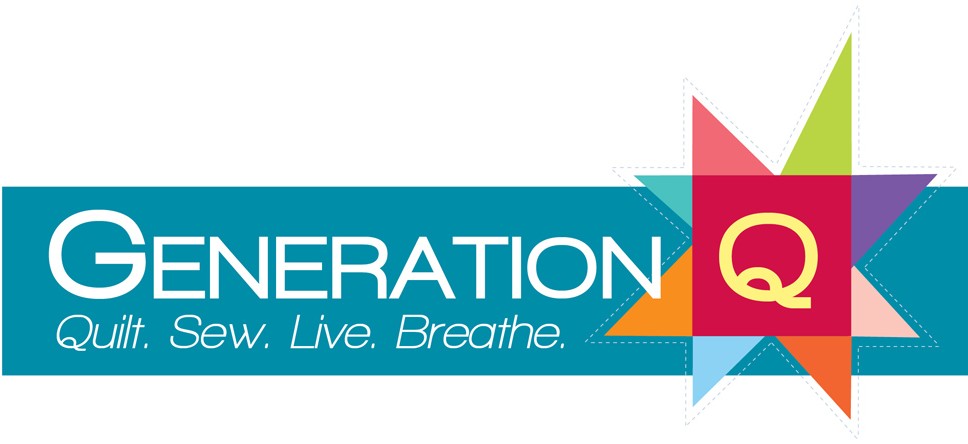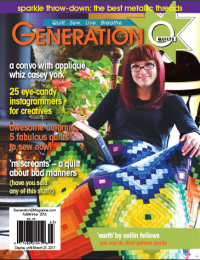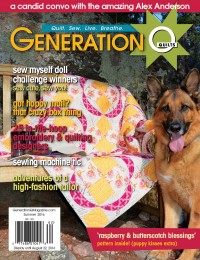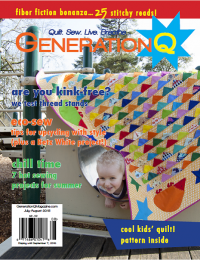If there’s anything the Internet has given us (besides lots of weird memes involving animals and Kanye West), it’s opportunity. I can still remember when my mom started quilting, back in the early ‘80s, and she had to drive several miles away to another town to what was probably the only quilt shop in the state to buy supplies, books, and patterns. Today, of course, just about everybody has a quilt shop, or a reasonable facsimile, nearby, and even if we don’t we can get anything we want or need online, sometimes instantly. Just this week, I downloaded an e-book version of a quilt book I’ve had my eye on, and today I bought a PDF bag pattern which was sent to my email inbox just a few hours after I ordered it.
While the book was distributed through one of the major quilt and craft publishing houses, the pattern was from an independent designer, working out of her home in her spare time and selling her work on Etsy. Today, anybody can whip up a pattern and sell it online. Or can they? I’ve done a lot of self-publishing, but I’ve never tried to design and sell a pattern. I wondered just what it takes to put together a quilt pattern, from concept to storefront: What supplies do you need? How many hours does it take? What does it cost?
I contacted four independent blogger-designers and one professional (for comparison) to see what they put into bringing their creations to the marketplace. The independent designers I spoke with were Elizabeth D. of Don’t Call Me Betsy, AnneMarie of Gen X Quilters, Rachel of Stitched In Color, and Faith of Fresh Lemons Quilts, and the professional designer was Terry Atkinson of Atkinson Designs. (You can also click on any of their patterns shown here to be taken direct to their storefronts.)
1. How many hours would you estimate you spend on creating the initial design of the quilt pattern? Elizabeth, AnneMarie, and Rachel all estimated two to four hours for the initial design process, while Faith put hers at 5-12 and Terry estimated 10-20.
2. Do you use software such as EQ7 or Illustrator to help in the design process? Rachel and Elizabeth keep it low-tech with just paper and pencil, though Elizabeth will use Illustrator once she is happy with her on-paper version. AnneMarie uses EQ7 and Faith uses Photoshop, while Terry uses Illustrator and InDesign.
3. How many full versions of the quilt will you make in the course of testing the pattern? The independents all said they made only one quilt (though Rachel admitted to having made 4 versions of her makeup roll, a pattern that proved particularly challenging.) Elizabeth and Faith have a friend make the quilt as well, while AnneMarie belongs to a group of pattern testers, where she has two members make her pattern as well. Terry’s company makes 2-3 quilts, “more if there are things that aren’t working.”
4. How many hours does it take to make one quilt? These answers varied widely, and I believe this may be more from the fact that we often just don’t pay attention to the time when we’re quilting (and that we often have to quilt in our spare time) than from any great disparity in skill or sewing style. The average answer was around 15 hours for the independents and Terry said definitely 10-12 hours minimum. (Whenever I am asked this question, I always answer, “For-freakin’-ever.”)
5. Do you get fabric free from manufacturers? So, if you start designing and selling your own patterns, will you have truckloads of fabric from big companies wanting to promote their lines? Eh, not so much. Rachel gets only about 20% of what she uses free, while Faith only received fabric once for a magazine pattern. AnneMarie got some when she made pattern tutorials for Moda Bake Shop and Riley Blake Cutting Corners, but otherwise it’s all her own. And Elizabeth? “Oh, my. I wish I did, but no, I don’t.” (Of course, Elizabeth just started publishing her own patterns, so there’s time!) Terry didn’t say whether she’s got fabric companies knocking down her door, but did say she prefers to choose her own fabrics so that she’s not limited to using one line.
6. Do you do the layout and design of the printed or PDF pattern yourself? All the independent designers are self-publishers, using software such as Photoshop, Illustrator, Microsoft Publisher, and word processing programs (such as Word or iPages). Terry also does it herself, only hiring a graphic artist for ads and book covers.
7. Where do you sell your patterns? Faith and AnneMarie sell their patterns direct to the consumer through Etsy as well as on their own websites. In addition to selling through her site, you can also find Rachel’s patterns in some online fabric shops, and Elizabeth is selling through Big Cartel and Patternspot. Terry, however, only sells wholesale to online and brick-and-mortar shops.
8. What do you estimate to be the TOTAL number of hours (from design conception to placing the pattern for sale) that it takes to create a quilt pattern? Again there was a lot of variation here, and probably due to the difficulty in trying to estimate something that most everyone had never tried to quantify before. Rachel answered 16-48, depending on the complexity of the pattern. Faith said 48 and AnneMarie said 50. Elizabeth estimated 30. Terry said it takes anywhere from a month to several months to get a pattern to market.
So what does it cost to make a pattern and put it out for sale? Just doing some rough calculations, if a pattern takes 35 hours to create, and we assume only minimum wage for those hours used, that comes to $253.75 in personal labor. We all know that the materials for a quilt can easily hit $200 or more. And even if you can design the quilt on paper, you’ll still need some sort of design software for the pattern itself. Apple’s iPages (a word processing program) runs about $79; Microsoft Publisher is about $140. The Adobe suite (Illustrator/Photoshop/InDesign, etc) can run well over $1000, unless you can get an academic version for $200 or so.
Pattern designing—just like quilting—is an investment in time and money. Many of the smaller independent designers really only sell a few patterns a month, so it can take a while just to break even, not to mention make a profit. Eight or ten dollars may sometimes seem like a lot of money, even for a fairly simple pattern, but, as Rachel emphasizes, “The experience of being inspired and enabled to create is what most of us treasure. Only you can decide how much that is worth to you.”












COMMENT #1
Ooh, great post, I love seeing ‘behind the scenes’, thank you 🙂
COMMENT #2
Thanks so much for this post. As an independent pattern designer myself, it was nice to get a peek into how some of the others work.
COMMENT #3
Thanks for doing this research. I’m starting to think about doing some patterns. Re-making the same design is a very interesting process, so different from spontaneous, artsy, one-of-a-kind quilts.
COMMENT #4
Oh man, I relate more to Terry’s numbers! I write appliqué quilt patterns & it takes forever! Lol I use Adobe Creative Suite for everything & the illustrations alone can take several weeks. & I want to mention the importance of photography. The cover image sells your pattern & you’ve got to have a good camera & decent photoshop skills to make a great photo. If you include step by step photos, then they all need to be very clear & cohesive. But I must say, the first pattern you make takes the longest because you have to create a layout & branding from scratch. Once you have that down, it gets easier.
COMMENT #
Rebecca do you know where I can find a pattern writer for my applique wall hangings?
COMMENT #
Lola,
If you send me an image of one of your applique wall hangings, we’ll see if we know someone who might fit the job. You can send that to melissa@generationqmagazine.com. Thanks! mjtm
COMMENT #5
Fantastic post, thank you! I’ve toyed with the idea of selling patterns for ages but am forever on the fence about whether it’s worth the trouble. This was very informative.
COMMENT #6
Great info! I think any creative business is an investment of time and money. But if you believe in what you are doing, you can trust that it will pay off in personal fulfillment, even if you can’t break even financially in the first few goes. I recently talked to a handmade jewelry shop owner who says she has put everything she’s earned back into the business for the first two years, to keep it growing. In her third year, she expects to take home a paycheck. Interesting perspectives!
COMMENT #7
Great behind-the-scenes look Megan! I have wondered what it takes to do your own patterns. Now I have a better idea!
COMMENT #8
I agree, depending on the pattern it can take anywhere from 5 to 20 hours. I use EQ6, Illustrator and Publisher depending on the pattern, the line I’m working with and who it’s for. Reading & re-reading and a whole lot of math are essential parts of the design process.
Teri
COMMENT #9
Yes, thanks for the article. I agree with Debbie, as an independant designer, it’s good to read how others work.
COMMENT #10
very cool info… i know its loads of work so i’ll leave it to the professionals 🙂 and collect as many as possible!
COMMENT #11
Great post! I’ve been pondering making my own patterns and this was very helpful!
COMMENT #12
Thanks for this informative post. Researching this subject is not easy, here’s another one trying to “break into the business”. This was eye opeining ( and a little disappointing) glad I found your blog and your blog roll looks good too! Thanks again!
COMMENT #13
As a creator of plush animals from recycled clothing, my work is generally sold as a finished product rather than in the form of a pattern (since I’m too attached to my animal patterns to sell them!). However, I also quilt a fair bit on the side. I’d love to create quilt patterns (to which I don’t have the same maternal attachment) to sell at my Etsy shop. Now that EQ7 for Mac is finally on the market – I’m looking into it. For reference, I used EQ6 prior to purchasing my Mac, so I am quite familiar with the ins and outs of Electric Quilt in general. Since I wasn’t in the habit of creating PDF’s at the time, I can’t recall if I could have made them with EQ6. What I really want to know is: I see that AnnMarie uses EQ7 and I’m just wondering if that is all I need to create patterns from start to finish to sell in PDF form at my shop.
COMMENT #14
This article was very helpful in figuring out how a design business runs at a high level. There is so much information to sort through, so thanks for filling in some of the gaps!